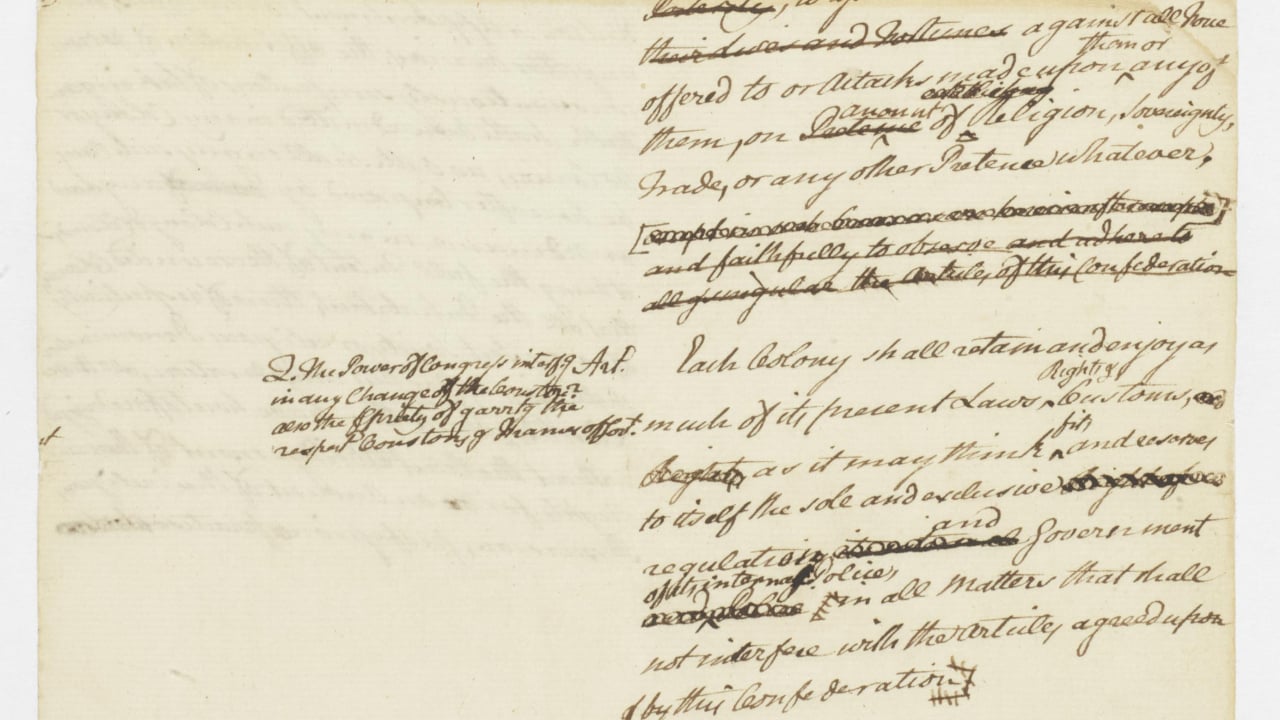On Nov. 15, 1777, the Second Continental Congress finalized the Articles of Confederation after 16 months of debate.
The Articles were then sent to the states for consideration, and once ratified, formally united the 13 states into a confederation that retained for each state its “sovereignty, freedom and independence.”
Congress began considering a plan for a new government even before declaring independence. On June 7, 1776, following instructions from Virginia’s Fifth Revolutionary Convention, Richard Henry Lee introduced a resolution in the Second Continental Congress to declare independence, along with a call to form foreign alliances, and to formulate a “plan for confederation.”
Five days later, Congress formed a committee made up of one representative from each colony to discuss a confederation. John Dickinson chaired the committee, and exactly one month later, it introduced a plan.
The initial draft of the Articles was primarily written by John Dickinson. This first draft in his handwriting still exists today. It was a culmination of years of discussion and was influenced by political several treatises including Thomas Paine’s Common Sense along with several earlier plans for a colonial union.
Formal discussions on unifying the colonies began in the summer of 1754 when representatives from various colonies convened in Albany, New York, to discuss rising tensions with the French and their Indian allies. Benjamin Franklin was an influential delegate. Before the conference, he wrote “Short hints towards a scheme for uniting the Northern Colonies.” These notes served as a starting point for what became the Albany Plan of Union.
The colonial representatives in Albany voted to recommend the plan, but it subsequently failed to win support from the colonial legislatures or from the British Parliament. Nevertheless, the plan served as a foundation upon which future confederation proposals would be built.
The Albany Plan was influenced by an even earlier confederation. A little-known agreement drafted just 23 years after the Pilgrims landed at Plymouth Rock could be considered the great great great grandfather to the Constitution.
Using the Albany Plan as a starting point, Franklin drafted and introduced the Articles of Confederation and Perpetual Union to the Second Continental Congress in 1775. A number of principles and structural proposals in Franklin’s plan eventually found their way into the Articles of Confederation and later the Constitution. Significantly, Franklin’s proposal featured a strict division of powers.
As legal scholar Robert Natelson put it in an article published by the Penn State Law Review, Dickinson’s draft “contemplated a looser union than Franklin’s, but a tighter one than that created by the finished Articles.”
Natelson argues that Franklin’s draft was primarily perceived as stronger due to the general power given to Congress to regulate commerce. Dickinson’s draft replaced this broad commerce regulating power with a much narrower authority to regulate weights and measures.
According to historian Jane Calvert, Dickinson was strongly influenced by his close association with the Quakers. Specifically, the federated structure of Quaker meetings informed his views on political federalism – the division of power between a general government and the states united in a confederation. This served as the foundation of his political plan. Dickinson thought the general government needed to have significant but specifically limited power in order to hold the confederation together, as Calvert explained.
“He had been pondering the relationship of the colonies to Empire at least as early as his work representing merchants in the flag-of-truce trade in the late 1750s. For federalism to work, whether in a religious or political body, there must be a strong, superintending authority with distinct limits.”
Dickinson introduced a number of radical (for the time) ideas into the initial draft, including protections for native tribes, the abolition of slavery, religious liberty, and the rights of women.
One of his most controversial proposals was for an end to slavery. Dickinson was a slaveholder, but starting in 1777, he subsequently freed his slaves while he was still alive. In his draft, he wrote, “Should there not be an Article to prevent those who are hereafter brought into these Colonies, from being held in Slavery in these Colonies?”
Dickinson was also far ahead of his time in terms of his views on women. His draft included gender-inclusive language. He wrote, “No Person or persons in any Colony living peaceably under the Civil Government shall be molested or prejudiced in his or their {his or her} Person or Estate for his or her religious persuasion or Practice.”
Calvert explains, “To be clear, he first wrote ‘his or their,’ then he crossed it out and replaced it with ‘his or her.’ This is the first instance of gender-inclusive language used in a substantive provision of an Anglo-American constitution.”
Among the compromises made before the final version of the Articles was introduced were the creation of a unicameral legislature with specific, narrow powers; giving each state a single congressional vote; and ensuring the sovereignty of each state by refusing the national government the authority to tax or regulate commerce.
Some scholars claim that the final Articles of Confederation were significantly different from Dickinson’s first draft and that they created a much weaker confederation than Dickinson contemplated. Natelson disputes this, writing, “The final draft was weaker than Dickinson’s, not so much for reasons of substance but because it was more explicit on the reservation of nondelegated powers to the states.”
“The Dickinson draft stated that Congress could not ‘interfere with the internal Police of any colony, any further than such Police may be affected by the Articles of this Confederation.’ Based on contemporary usage of the term ‘internal police’ and the enumeration of powers given the confederation, this [the Dickinson draft] left a great deal of power in the states.”
THE PLAN
The Articles were the culmination of months of debate and numerous compromises.
As Congress considered the new plan, a number of contentious debates arose. Three of the most significant centered around the apportionment of costs, representation, and the powers of Congress. There were also intense debates about Western land holdings. These debates continued through the ratification of the Constitution.
A significant sticking point was fear that a general government would infringe on the powers of the individual states. Thomas Burke of North Carolina led a drive to more specifically reserve powers to the states. Ultimately, Congress came to a consensus by including language in the Articles explicitly guaranteeing that each state would retain its sovereignty.
“Each state retains its sovereignty, freedom and independence, and every Power, Jurisdiction and right, which is not by this confederation expressly delegated to the United States, in Congress assembled.”
Natelson pointed out that James Wilson, like many historians today, saw this as a significant difference between the draft proposed by Dickinson and the final Articles adopted by the states. Natelson characterized this as “an exaggeration.”
“I have examined both drafts point by point, and to me, the difference seems to be more one of emphasis than of substance. This conclusion is buttressed by the fact that Burke was not opposed to a fairly strong union. In 1780, he promoted bills to give Congress the power to levy duties and regulate commerce. Id. Burke simply wished a more explicit statement of what was reserved.”
Under the finalized plan, states could send no fewer than two and no more than seven representatives to Congress, and voting in the unicameral legislature was by state, each having one vote. The legislature’s power was limited to a list of enumerated topics specified in Article IX.
Giving each state a single vote on all proceedings created a system with each state on an equal footing with the others. This prevented the large, populous states from trampling over the will of the smaller states.
Nine of the 13 states had to approve most significant actions by the general government including declaring war, borrowing money from foreign powers, entering into treaties, appointing a commander-in-chief, and printing money.
The Articles established that expenditures by the United States would be paid with funds raised by the state legislatures apportioned in proportion to the real property values of each state.
Congress could issue requisitions for funds, but it lacked any enforcement or collection authority. It was up to each state to voluntarily pay its portion. Under the Articles, the Confederation Congress often struggled to raise revenue, and some states underpaid. This angered officials in states that paid in full, and was a leading motivator in calling for taxing power under the Constitution years later, despite the fact that some, like Patrick Henry, considered the requisition system the basis “of our political prosperity.”
Under the Articles, there was no federal judiciary or executive branch. Executive power resided in the governors of each state, with judicial authority remaining in the state courts.
It required the approval of all 13 states to amend the Articles.
The official title of the new constitution was “The Articles of Confederation and Perpetual Union.” Some take this to mean that the subsequent U.S. Constitution was an illegal usurpation of the Articles. However, in 18th-century legal terminology, the term “perpetual” did not mean “everlasting.” It simply indicated that the framework lacked any specific sunset date. Similarly, the 1783 Treaty of Paris secured a “perpetual” peace between the states and Great Britain. The War of 1812 threw that agreement by the wayside, just as the future Constitution supplanted the Articles.
The Articles were presented to the states for ratification shortly after they were finalized, but it took more than three years for all of the states to approve the framework. The Articles of Confederation were finally ratified on Feb. 1781, when Maryland voted to approve the new constitutional framework.
The Articles went into effect on March 1, 1781.




